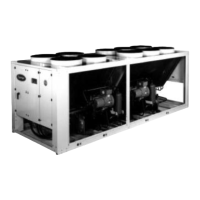6
Do not drain water circuits containing industrial brines,
without informing the technical service department at the
installation site or a competent body first.
Close the entering and leaving water shutoff valves and
purge the unit water circuit, before working on the compo-
nents installed on the circuit (screen filter, pump, water
flow switch, etc.).
Do not loosen the water box bolts until the water boxes
have been completely drained.
Periodically inspect all valves, fittings and pipes of the
refrigerant and hydronic circuits to ensure that they do
not show any corrosion or any signs of leaks.
• Inspect the unit for damage or missing parts. If damage
is detected, or if shipment is incomplete, immediately
file a claim with the shipping company.
• Confirm that the unit received is the one ordered.
Compare the name plate data with the order.
• The unit name plate must include the following
information:
- Version number
- Model number
- CE marking
- Serial number
- Year of manufacture and test date
- Refrigerant used and refrigerant class
- Refrigerant charge per circuit
- Containment fluid to be used
- PS: Min./max. allowable pressure (high and low
pressure side)
- TS: Min./max. allowable temperature (high and
low pressure side)
- Relief valve set pressure
- Pressure switch cut-out pressure
- Unit leak test pressure
- Voltage, frequency, number of phases
- Maximum current drawn
- Maximum power input
- Unit net weight
• Confirm that all accessories ordered for on-site
installation have been delivered, and are complete
and undamaged.
• Do not keep the 30HXC units outside where they are
exposed to the weather, as the sensitive control
mechanism and the electronic modules may be damaged.
The unit must be checked periodically during its whole
operating life to ensure that no shocks (handling accessories,
tools etc.) have damaged it. If necessary, the damaged parts
must be repaired or replaced. See also chapter “Mainte-
nance”.
Avoid spilling liquid refrigerant on skin or splashing it
into the eyes. Use safety goggles. Wash any spills from the
skin with soap and water. If liquid refrigerant enters the
eyes, immediately and abundantly flush the eyes with
water and consult a doctor.
Never apply an open flame or live steam to a refrigerant
container. Dangerous overpressure can result. If it is
necessary to heat refrigerant, use only warm water.
During refrigerant removal and storage operations follow
applicable regulations. These regulations, permitting condi-
tioning and recovery of halogenated hydrocarbons under
optimum quality conditions for the products and optimum
safety conditions for people, property and the environment
are described in standard NFE 29795.
Any refrigerant transfer and recovery operations must be
carried out using a transfer unit. A 3/8” SAE connector on
the manual liquid line valve is supplied with all units for
connection to the transfer station. The units must never be
modified to add refrigerant and oil charging, removal and
purging devices. All these devices are provided with the
units. Please refer to the certified dimensional drawings for
the units.
Do not re-use disposable (non-returnable) cylinders or
attempt to refill them. It is dangerous and illegal. When
cylinders are empty, evacuate the remaining gas pressure,
and move the cylinders to a place designated for their
recovery. Do not incinerate.
Do not attempt to remove refrigerant circuit components
or fittings, while the machine is under pressure or while it
is running. Be sure pressure is at 0 kPa before removing
components or opening a circuit.
Do not attempt to repair or recondition any safety devices
when corrosion or build-up of foreign material (rust, dirt,
scale, etc.) is found within the valve body or mechanism.
If necessary, replace the device. Do not install safety valves
in series or backwards.
ATTENTION: No part of the unit must be used as a walk-
way, rack or support. Periodically check and repair or if
necessary replace any component or piping that shows
signs of damage.
The refrigerant lines can break under the weight and release
refrigerant, causing personal injury.
Do not climb on a machine. Use a platform, or staging to
work at higher levels.
Use mechanical lifting equipment (crane, hoist, winch, etc.)
to lift or move heavy components. For lighter components,
use lifting equipment when there is a risk of slipping or
losing your balance.
Use only original replacement parts for any repair or com-
ponent replacement.
Consult the list of replacement parts that corresponds to
the specification of the original equipment.

